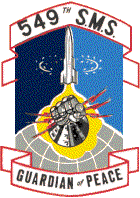|
|
|
Atlas Missile - Home Page |
|
549th Strategic Missile
Squadron - SAC's first ICBM missile unit
Contributed by
Ron Nettle
Mrsawdust@mediaone.net |
 |
Introduction |
|
|
The 549th Strategic Missile Squadron was the first SAC
operational unit to have ICBMs - the Atlas Missile. They were
deployed near SAC headquarters at Offutt AFB, Nebraska, most likely so
that the brass could be close by to establish procedures, etc. Prior
to that, the missiles were only assigned to the training units at
Vandenberg AFB, California. The Atlas program was short-lived.
Ron Nettle was at Offutt during the last year of their deployment and has
provided great photographs of the last Atlas being taken from Offutt.
He has also provided a map showing their deployment near Offutt and some
interesting comments, which appear below. Ron sent the photo of the
car decal at right, but does
ANYONE HAVE A COLOR PHOTO OF THE PATCH? |
|
|
Ron's Comments |
Marv, I have no story to tell. Even though I spent
3 years in Omaha at Offutt, the 3rd year was after the Atlas was
de-activated, so I got trained on (I believe) an ITT computer. Had no
idea as to it's mission. I was single back then, lived off base and was
a bartender in my off hours.
I do recall that when I arrived at
Offutt I was the second computer technician assigned to the computer
shop, and a welcome site. The guidance computer was manufactured by
Burroughs Corporation, later (1986) merging with Sperry to form Unisys.
Soon after I arrived in the shop I realized that these computers were
very reliable. There were 3 of them, one at each site, each having the
responsibility of working with the radar system, and performing guidance
to 3 missiles. Thus only one of the 3 missiles could be launched at a
time at the site. A "Secret" trajectory code was inputted into the
computer via a dozen or so rotary switches. After a launch (that never
took place) a new trajectory code would be loaded for the next missile
until all 3 had been launched.
Throughout my year and a half in the
shop, we had about 3 failures to repair. It's at this time that I asked
myself that "if I were to work for a computer company, I sure would like
to work for one with the reliability of this Burroughs Computer"!
Due to their reliability, I did a lot of
sweeping of floors and general clean-up. Each morning, a PM was
performed on the computers at the missile sites, including a Guidance
Simulation Exercise, loaded into the computer via punched mylar tape. If
any part of the Guidance Simulation failed, the diagnostics were run,
and the bad "major" component was found and replaced with a spare on
site. This is where I came in. The failing "major" component was then
returned to the base shop for repair. We would then run
diagnostics using this "package tester" unit, that was the size of about
3 side-by-side refrigerators, with more switches than I could count. We
would replace the bad component and return it to the missile site as a
spare.
As the months passed, more and more airmen
were trained and assigned to the shop until we had about a dozed of us
sweeping floors and cleaning up. There were also a dozen or so computer
technicians assigned to the 3 sites, covering all three shifts, rotating
on a 24 hour basis. They were the one's performing the Simulation
Exercise. As you can see, they too had plenty of time on their hands as
well, since the daily test only took about an hour to run.
I did pull the site duty for a while on the
24 hour schedule. On our non-productive time we would leave the block
house and walk down to the launch pad and snoop around. The missile was
an impressive site, laying horizontal in the bay. Everything was
spotless, either freshly painted or stainless steel.
When the de-activation began, I was working
the shop duty again, and since there was no priority, and the computers
were shut down, the twelve of us would select which day of the week to
work. My day was Thursday. That lasted for a couple of months until I
got re-assigned to the ITT computer, then training started all over
again. That training was unique, because it was performed by civilians
at Offutt (rather than Keesler AFB), and each day consisted of a one
half hour break between 10am and 10:30am. At this time we went to the
local day room to watch the Andy Griffith Show, then back to the
classroom.
Did I say I have no story to tell?
I got out of the USAF on Oct 31, 1965, and
started working for Burroughs Corporation as mentioned above. This week
I will have 36 years with them. Currently the company (now UNISYS) is
going through an employee reduction program, looking to reduce the roll
call by 3000 (about 10%). First a retirement package is being offered to
those 55 and older, then the remainder will be the result of layoff's. I
plan to take the retirement package, so my last day will be Dec 31,
2001.
I have included the 11 pictures (10 photos and
map) in JPG
format. The
pictures show the last of the 9 missiles being removed from the Missouri
Valley site.
|
|
|
